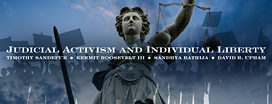Sandhya Bathija’s argument that meaningful judicial protection for constitutional rights, including economic liberty, would somehow harm the working class, is pretty hard to take seriously, even aside from her cartoonish pseudo-history. Anyone concerned about the depredations of the wealthy and powerful must join me in advocating strong judicial protections against a legislative process in which the working class operate at a systematic disadvantage. The powerful don’t need courts to protect their rights—they have enough political influence. Individuals, not so much.
Consider Lawrence v. Texas. There, the Supreme Court applied meaningful constitutional scrutiny to invalidate legislation enacted by the politically powerful to restrict the rights of a minority group. The right to engage in homosexual sex was, of course, not an “agreed-upon liberty explicitly listed in the Constitution,” least of all in Texas. Yet the Court rightly held that the word liberty means something more than just the permissions the majority deigns to give us. The courts came to the defense of the individual who could not realistically hope to persuade the legislature to respect his freedom. It’s disappointing to see that Ms. Bathija thinks Lawrence was wrongly decided.
Or take Kelo v. New London. In that case, powerful, wealthy, politically connected developers obtained legislation which allowed them to seize property from politically powerless individuals, in violation of the Constitution’s promises that property shall not be taken for private use or without due process of law. The Court looked the other way, allowing cronyism to trump constitutional protections—a tremendous victory for corporate welfare at the expense of the underprivileged. Unsurprisingly, the most common victims of eminent domain for redevelopment are the poor and members of racial minorities. But I guess, as Ms. Bathija puts it, “As the will of the people changes, so do our definitions of liberty, for better or worse.”
One might say the same of other Great Moments in Judicial Restraint, such as Buck v. Bell, Korematsu v. United States, or Plessy v. Ferguson. In all these cases, courts refused to interfere in the “democratic process,” and allowed legislative majorities to enforce their will on powerless minorities whose only hope for protection had been the court system. Ms. Bathija’s coldness toward the rights of these minorities would likely shock many people who otherwise call themselves Progressives.
Of course, Ms. Bathija isn’t thinking about Fred Korematsu or Susette Kelo. Her primary concern is ensuring that dubious federal legislation never has to face any serious constitutional scrutiny. To that end, she is willing to advance legal arguments that would have these deplorable results—and worse, because there actually is a real class issue buried in the discussion of “judicial restraint.”
The Dogma of Deference encourages the growth of a class system which privileges the political class against the citizen class in this country. The confirmation process has become a ritual in which politicians demand that nominees genuflect to the Dogma of Deference until they are convinced that Congress will face no realistic restraint on their powers if they confirm the nominee. The result is a judiciary made up of judges who are either sufficiently deferential, or duplicitous enough to appear so. The only sacred element in the process is the notion that the legislature should get to do whatever it wants. Over time, the judiciary, which the Constitution promises will serve as a check against lawmakers, is pressured to become their servant.
What opportunity can people like John Geddes Lawrence or Homer Plessy or Carrie Buck or Raleigh Bruner have when taking on this entrenched political class? The legislature is easily manipulated by powerful private interests, who seek legislation that benefits them and burdens their rivals—whether it be established moving companies blocking new competitors, or bigots using the law to persecute gays. The founders called this tendency to abuse “the mischiefs of faction,” and they designed a system to prevent these mischiefs as much as possible. Democratic control, in limited, carefully designed ways, was an important part of that—but so was meaningful judicial enforcement of constitutional limits on the legislature. To reduce those protections out of a thoughtless infatuation with “democracy” in the abstract—an infatuation that makes no acknowledgment of rent seeking and factional problems that often block ordinary people from obtaining legislative protection—is to radically undermine constitutional protections. Yet that is what the Dogma encourages.
If the legislation Ms. Bathija is so fond of is such a good idea, it should be able to withstand judicial scrutiny. If it’s unconstitutional, but still a good idea, then amend the Constitution. But demand judicial restraint simply to prop up the regulatory welfare state, notwithstanding the tremendous harms that it inflicts on the very people one claims to speak for? That’s short-sighted.

